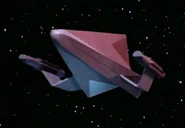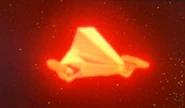The class J starship was a small, antiquated starship design used by the Federation and independent traders alike well into the mid-23rd century. (TOS: "Mudd's Women", "The Menagerie, Part I")
History
In 2266, Harcourt Fenton Mudd possessed an unregistered small class J cargo ship which he utilized as a transport vessel. While attempting to outrun the USS Enterprise, Mudd piloted the ship into an asteroid belt, in the process causing his engines to overheat. Disabled, the ship was ultimately destroyed by an asteroid collision, but not before the Enterprise was able to beam off all of the ship's inhabitants. (TOS: "Mudd's Women")
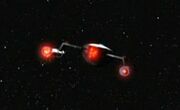
With overheated impulse engines and warp drive
The same year, Starfleet maintained an old class J starship for use as a cadet training vessel. During an inspection by Fleet Captain Pike, a baffle plate ruptured, exposing the crew to harmful delta rays. Pike received an extremely high dose which ultimately left him an invalid, as he went in to rescue the cadets. (TOS: "The Menagerie, Part I")
The Deneva colony also had a class J starship at their disposal, described as a one-man vessel of Denevan configuration. The Enterprise was unable to intercept it, after it came into sensor range, even at warp 8 before it was destroyed by the heat of the Denevan sun. (TOS: "Operation -- Annihilate!")
In 2269, the Federation operated the space cruiser Aurora. The ship was stolen by Dr. Sevrin and five of his followers in search for the mythical planet Eden. The ship was destroyed when attempting to pull free from a tractor beam. (TOS: "The Way to Eden")
Ships of the class
- Aurora
- Unnamed class J starships
- Denevan starship
- Mudd’s freighter
Appendices
Appearances
Background information
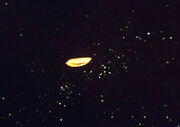
|
File:AuroraFore.jpg |
It was initially believed that when the J class was introduced in Star Trek: Enterprise that the writers were tipping their hat to the ship class that was twice referenced in the original Star Trek. This association was discovered to be false when "Mudd's Women" was remastered and Mudd's ship was given a completely new design from what was shown in Enterprise.
Slight variations were made in this design's three remastered appearances. In the case of the Denevan starship, the original class J model, albeit slightly scaled down, was a reused to represent that ship as well. In the case of Aurora the engines were slightly modified and new windows were added.
Studio model
The studio model used in the original edition of "The Way to Eden" for the Aurora was a modification of one of the two Tholian starship studio models that previously appeared in "The Tholian Web", a necessity, as the studio was by then suffering from severe budget restrictions and simply had no funding left for new studio model builds. The modifications between the new design include the addition of warp nacelles to the model, taken from the AMT USS Enterprise model kit (no. S921 or S951), which were attached to the main body via nacelle pylons taken from the AMT D7-class model kit (no. S952), with the completed model finally being flown in "reverse".
In this configuration, the model was gifted by Paramount Television in 1974 to the Smithsonian Institution, where it made its first and, to date, only public appearance in the 1992-1994 Star Trek Smithsonian Exhibit, after having received an extensive restoration by Ed Miarecki and his staff at Science Fiction Modelmaking Associates. [1] On the occasion, Miarecki made use of the opportunity to cast an additional copy of the model to represent the original Tholian starship as well in the exhibition, as was later confirmed by Gary Kerr. (source) The actual sibling model was in effect still in existence, as it turned out to be retained by former Original Series Set Designer John Jefferies, who sold his possession at auction, nine years later.
When the remastered version of the Original Series came along, its Visual Effects Producer Michael Okuda decided to make use of the opportunity to retcon a new CGI starship design for those instances where a simple nondescript optical was used originally to represent a generic transport/freighter, or was not featured at all, yet emphatically referred to in onscreen visuals as was the case with the Denevan ship. As such the newly designed Class J CGI model was featured in the 2008 remastered episode versions; firstly in "Operation -- Annihilate!" as the Denevan starship, and subsequently in "Mudd's Women" as, what Okuda had called, "Mudd’s freighter". [2] In both these cases, care was taken to have the model only featured at a great distance and barely discernible, in order to stay as close as possible to the "feel" of the original episodes. In a mischievous nod to Harcourt Mudd, Okuda had intended to name his freighter Stella, the name of the wife Mudd was running from; "If we had seen the ship more clearly in remastered ep, I would have had the ship so labeled," stated Okuda, referring to the great distance Mudd's ship was featured. [3]
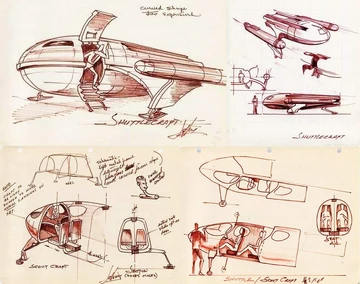
| |

|

|
The model appeared for a final time in more detail in the remastered version of "The Way to Eden" as the Aurora freighter. Okuda, who actually had designed the vessel himself [4], confirmed that the CGI Aurora was a slight modification of the Class J CGI model, with larger engines and new windows. The registry NC-17740 on the nacelles, illegible on screen, was the tail number from Matt Jefferies' (brother to Set Designer John) 1935 Waco YOC biplane. [5] Additionally, the remastered CGI Aurora design shares a design lineage very similar to Jefferies' original 'teardrop' exterior design for a number of early "shuttlecraft/scout craft" sketches (featured in the Star Trek: The Original Series Sketchbook, pp. 86-87), which he, as Original Series art director and aeronautics expert, in effect had wanted all along in the first place. [6] And indeed, this actually corresponded with the script draft of 12 November 1968, where the Aurora (or rather Argo in that draft version) was described as "(...)small, rather like the Enterprise shuttlecraft." (Scenes 3 & 5, p. 2) Jefferies' "curved shape" designs were ultimately rejected for being "too expensive" to produce, in favor of the design that would be associated with the Class F shuttlecraft. (see Class F shuttlecraft model for further particulars) It was therefore Michael Okuda, an admirer and personal friend of Jefferies in later life, who at long last fulfilled, in part at least, the vision for the design Jefferies originally had.
The new, digital model was constructed at CBS Digital in the Autodesk Maya CGI software. (Sci-fi & fantasy modeller, Vol. 26, p. 49) In 2015, former Star Trek Producer Dave Rossi made the entire starship database of the remastered Original Series available to Project Manager Ben Robinson for representation in the British partwork publication Star Trek: The Official Starships Collection. [7] However, these models, including the Class J, were not quite production and/or print ready as the models needed to be converted into LightWave 3D, the software package of choice for the vast majority of Star Trek digital modelers. Robinson assigned Fabio Passaro, among others, to this chore. [8]

